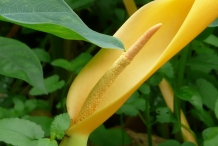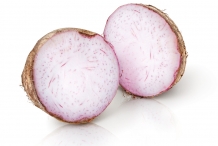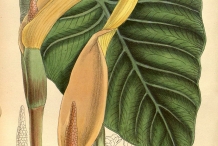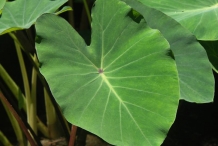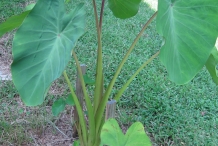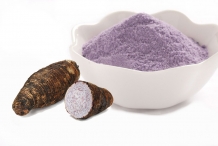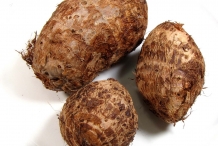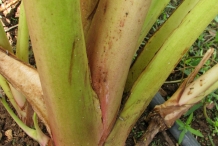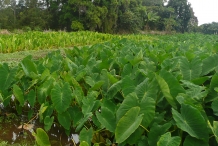Plant
Taro also referred to as kalo in Hawaiian, and also as dasheen in certain other areas around the globe is a glabrous, acaulescent, mainly diploid, herbaceous, perennial plant growing up to 50–150 cm high. It thrives in hot, humid conditions and is found growing in moist forests and wet areas in riparian habitats, riverbanks, along streams, marshes and canals or cultivated near farmhouses, in water fields or as under-planting in coconut groves. It prefers deep, well-drained, friable loams soil particularly alluvial loams, with a high water table. The plant has white, adventitious and fibrous root and a massive, fleshy, starchy modified subterranean stem (corm) at the base. At the apex of the corm is a whorl of petioles bearing large leaves with blades pointing obliquely downwards, 23–55 cm × 12–38 cm. Petioles are robust, uniformly light or dark green, with dark streaks of violet, erect, to 100 cm long, inserted 3–7 cm from base of blade. It has huge “elephant ear” like leaves that are heart shaped leaves 2-3′ long and 1-2′ across on 3′ long petioles. Flowers are yellow to orange, deciduous or withering; the spathe surrounds a spadix yellow, much shorter than the spathe. Plant later develops berries that are thin walled, green, ellipsoid and 3–5 mm in diameter containing a few ovoid, ridged, pale- yellow, small, albuminous seeds, and 1.2–1.5 mm × 0.7–1 mm.
Fruit
Taro belongs to the family Araceae that includes a number of species that produce edible tubers or corms. Plant bears a massive, fleshy, starchy modified subterranean stem known as corm. Corm vary significantly in size and are round, cylindrical and elongate, up to 35 cm long and 15 cm across, frequently enclosed by a small number of secondary corms or cormlets known as cormels. Corms consist of the skin, cortex and core; the skin is rough, fibrous and brown colored or covered with concentric rings of leaf scars and scales. It has purple, white, yellow or pinkish colored flesh depending on the variety of corm. Corm usually weighs around 1-2 pounds, but can weigh eight pounds. Corm has nutty flavor just like that of water chestnuts and is sweet vanilla, floral and potato-y taste. Because of its wonderful taste as well as it high nutritive value it is cultivated and consumed throughout the world since pre-historic time in several food items.
History
Colocasia esculenta also known as Chinese Potato, Cocoyam, Colocasia, Curcas, Dalo, Dasheen is thought to have originated from tropical Asia. Taro seems to have originated in India and spread eastwards to Burma and China and southwards to Indonesia. Afterward, it was taken to Japan, Hawaii, Melanesia and Polynesia; in historical times, it spread to Egypt and the eastern Mediterranean, thereafter to Africa, to the Guinea coast and to the Caribbean. It has been vigorously grown throughout tropical and subtropical regions. Today, it is grown throughout the West Indies and in West and North Africa. In Asia, it is widely planted in south and central China and is grown to a lesser extent in India. It is now a staple food in many islands of the Pacific including Papua New Guinea.
Nutritional value
Apart from their sweet vanilla, floral and potato-y taste taro is a good source of nutrients, vitamins and minerals. Consuming 104 gram of taro offers 0.294 mg of Vitamin B6, 27.52 g of Carbohydrate, 0.179 mg of Copper, 0.398 mg of Manganese, 2.48 mg of Vitamin E and 615 mg of Potassium. Moreover many Amino acids 0.024 g of Tryptophan, 0.072 g of Threonine, 0.056 g of Isoleucine, 0.115 g of Leucine and 0.07 g of Lysine are also found in 104 gram of taro.
Health benefits of Taro
Taro is healthy, and is also loaded with potassium, that is an important mineral for a lot of bodily processes. Taro also includes several calcium, vitamin C, vitamin E and B vitamins, in addition to magnesium, manganese and copper. Taro leaves include great quantities of vitamins A and C, fiber along with a comparatively large quantities of protein. Listed below are some health benefits of Taro:
1. Cancer Prevention
Taro root plays an important part for the antioxidant activity in our body. High levels of vitamin A, vitamin C, and various other phenolic antioxidants found in taro root helps to boost immune system and help eliminate dangerous free radicals from our system. Free radicals are actually the dangerous byproducts of cellular metabolism that may result in healthy cells to mutate and turn into cancerous cells. By eliminating these free radicals, our general health is almost guaranteed! Cryptoxanthin, which is found in taro root, is directly related to a lowered chance of developing both lung and oral cancers.(1)
2. Reduce Symptoms of Rheumatoid Arthritis
Taro roots are extremely beneficial for overcoming rheumatoid arthritis because low levels of vitamin B6 are related with increased signs of rheumatoid arthritis (RA), like more severe pain. Several researchers conclude that people with RA require comparatively more vitamin B6 than healthy people because they experience constant muscle aches and joint pain due to chronic inflammation. Vitamin B6 benefits include curbing pain and can be useful in supplement form for controlling aches in the muscles and joints due to arthritis.
3. Blood Pressure and Heart Health
Taro root s consists of considerable amount of potassium which is considered other essential minerals that are essential to remain healthy and efficient. Potassium not only enables healthy fluid transfers between membranes and tissues throughout the body, but also helps to relieve stress and pressure on blood vessels and arteries. By relaxing the veins and blood vessels, blood pressure can be reduced and stress on the overall cardiovascular system is reduced. Potassium is related to increased cognitive function because neural connections can be boosted when blood pressure is reduced and fluid transfer between neural membranes is optimized!(2)
4. Immune System Health
Taro roots play an important role in the immune system. Vitamin C is found in taro roots which help to encourage immune system to create more white blood cells which help to defend the body from foreign pathogens and agents. Additionally vitamin C acts as an antioxidant, which moderately prevents the development of conditions such as heart disease and cancer.(3)
5. Cramps
Consuming high potassium foods is directly related with decreased muscle cramping and improved muscle strength. Taro roots consist of considerable amount of potassium 615 mg which is 13.09% of the daily recommended value. Muscle cramps are one of the common side effects of low potassium levels. This happens when athlete becomes dehydrated and isn’t consuming enough potassium rich foods before and after exercise.
6. Digestive Health
Taro plays an important role in digestion because it consists of high level of dietary fiber (a single serving contains 11.32% of the daily requirement of dietary fiber. Fiber is very important for supporting our gastrointestinal health. Fiber helps to add bulk to our bowel movements, thus helping food move through the digestive tract and facilitating improved digestion. Apart from that it can help to prevent certain conditions like excess gas, cramping, bloating, constipation and even diarrhea. A healthy, regulated gastrointestinal system can significantly boost your overall health and reduce your chances of various types of cancer.(4)
7. Enhances Learning
Taro roots consists of Vitamin B1 which is also known as thiamine is a crucial vitamin for increasing focus, energy, fighting chronic stress, and perhaps preventing memory loss. Several researches have linked thiamine deficiency to problems learning and retaining information. One study showed that thiamine caused quick reaction times and feelings of clear-headedness in those taking tests. Taro root consists of 0.099 mg of vitamin B1 which is 8.25% of the daily recommended value.
8. Boosts Vision
As we have previously mentioned, taro root is loaded with several antioxidants, like beta-carotene and cryptoxanthin. These antioxidants can also help to improve vision as well, by preventing the free radicals from attacking ocular cells and causing macular degeneration or cataracts!(5)
9. Helps Maintain Dental Health
Taro roots consist of phosphorus which is essential for both bone health as well as maintaining teeth and gum health. Calcium, vitamin D and phosphorus all play an important role in the formation and maintenance of dental health by supporting tooth enamel, jaw-bone mineral density and holding the teeth in place, too — therefore, these minerals and vitamins can also help heal tooth decay.
10. Diabetes
Apart from proper bowel movement dietary fiber can also help lower the chances of developing diabetes because it helps to regulate the release of insulin and glucose in the body. If you consume sufficient amount of taro root in your regular diet then you can manage your glycemic levels and lower you chances of developing diabetes. If you have diabetes, then fiber-rich foods like taro root can help prevent the spikes and plunges in blood sugar that can be so hazardous.(6)
11. Thickens Hair
A taro root consists of significant amount of vitamin E which is a powerful antioxidant that helps to decrease environmental damage to your hair. It also promotes circulation to the scalp. Vitamin E oil can retain the natural moisture in your skin, which help your scalp from becoming dry and flakey. This oil will also make your hair look healthier and fresher. You can use a few drops of vitamin E oil on your hair, especially if it is looking dry and dull.
12. Circulation Stimulation
Taro roots consist of several mineral contents. But the presence of iron and copper in taro root make it an important food to prevent anemia and boost circulation throughout the body. Both Iron and copper are essential for the production of red blood cells that carry the all-important oxygen to our body’s systems and cells. By decreasing the chances of anemia (iron deficiency) and boost the flow of blood through the body, you can speed overall metabolism, growth of new cells, and general oxygenation of the body that is always a good idea to keep organs and systems functioning at their optimal levels!(7)
13. Prevent Bone Loss
Copper present in taro roots plays an important role in slow down bone loss and osteoporosis in older women when taken in combination with other important minerals like zinc, calcium and manganese. Copper has bone-strengthening properties and its collagen-forming qualities encourage strong bones and connective tissues. Taro roots consist of 0.179 mg of copper which is 19.89% of the daily recommended value.
14. Skin Health
Taro roots is extremely beneficial to those who wish to keep their skin hydrated as well as protected since it consists of sufficient amount of vitamin A and vitamin E. Each of these vitamin helps to eliminate skin problems and boost overall cellular health. Regular consumption of taro roots helps to heal wounds and blemishes faster, wrinkles will be diminished and you can get a healthy and glowing skin.(8)
How to Eat
- Caudices, corms and cormels are boiled, or cooked, with meat or seafood in China.
- Sapal is a traditional fermented food in Papua New Guinea made by mixing cooked, grated taro corm with coconut cream and allowing it to ferment at ambient temperature.
- Achu is a thick porridge made by cooking and pounding taro corms and cormels in a mortar.
- Taro corm is a staple food in tropical Africa; in Cameroon, it is widely known for its famous dish achu.
- Corms are eaten boiled, fried or roasted as a side dish or are used for making fufu in Africa.
- Corm is also sliced and fried into taro chips.
- Corm is sliced and pieces fried in coconut oil or roasted and eaten mixed with aren palm sugar syrup or without in Indonesia.
- Thin corm slices are also deep-fried to make kripik.
- Boiled or steamed corms are eaten sprinkled with grated coconut.
- Steamed or roasted corm is pounded and boiled with rice with added salt.
- Corms are cooked and pounded into a paste that is allowed to ferment to produce ‘poi’ in Hawaii and parts of Polynesia.
- Steamed pudding is made from grated taro and coconut.
- Taro is used in baby food, chips, taro bread.
- Some of the taro food products available in Hawaii include poi, poi in the bag, taro bread or rolls, poi in the jar, taro pancakes, dehydrated poi, deep-fried taro chips, tropical fruit–taro flakes, taro cookies, taro burgers and Kūlolo (a sweet pudding made from baked or steamed grated kalo and coconut cream).
- Other forms of taro such as taro flakes, frozen taro chunks, dried taro chips and frozen taro cake are also available in other countries.
- Noodles can be made using 50 % taro flour and remaining equal proportions of rice and pigeon pea flours.
- Taro petioles are cooked and eaten in China and in Myanmar.
- Petioles and leaves are eaten in Nepal.
- Zuiki, a stalk of taro, is a traditional vegetable in Japan; raw zuiki is often boiled and vinegared to eat.
- Leaves are also consumed in sauces and stews, purees or soups.
- Taro leaves and leaf stalks are used as a leafy vegetable and potherb for soups and sauces or as relish.
- Petioles are cut into small pieces and cooked as sayur; the leaves are also cooked and eaten as bobotok, getjok or loto in Indonesia.
- Leaves are used to wrap salted fish which is steamed with grated coconut, lombok and salt.
- Lateral sprouts are relished and are called solor or seler.
- Leaves are used as a major ingredient in sauce preparations, among which black soup is the most popular, and the flowers are also used as a major ingredient in the preparation of achu soup in Western Cameroon.
- Taro inflorescences are used as cooked or fried food in some parts of the Solomon Islands, Papua New Guinea and Vanuatu.
- Taro roots are thinly sliced and fried to make chips called kochu bhaja in the East Indian state of West Bengal.
Other Traditional uses and benefits of Taro
- Leaf juice is styptic, stimulant and rubefacient and is useful in internal haemorrhages, otalgia, adenitis and buboes; the juice of the corm is laxative, demulcent and anodyne.
- Medicinal taro varieties were used to treat or cure human ailments.
- Juice of the petioles is styptic and may be used to stop arterial haemorrhage.
- It is occasionally used in treating earache and otorrhea and also an external stimulant and rubefacient.
- Juice of the corm is used in cases of alopecia.
- It acts as a laxative and is used in cases of piles and congestion of the portal system and also an antidote to the stings of wasps, snakes and other insects.
- Roots are used in catarrh and colic in Punjab and Cashmere.
- Ash of the tuber mixed with honey is applied for aphthae in the mouth.
- Stems are occasionally used medicinally, particularly in the treatment of snakebites.
- Heated tubers are locally applied to painful parts.
- Taro corm juices are extensively used for traditional treatment of body ache and baldness.
- It is used to treat diabetes mellitus by the rural community of Dhemaji district of Assam, Northeast India.
- It is used in traditional medicine to treat arterial hypertension, liver problems, ulcers, snakebites and rheumatism in Asia and Africa.
- Rasping from the corm is applied as a poultice to maturate boils and to treat snakebites and rheumatism in Gabon.
- Boiled young leaves are consumed to treat arterial hypertension and liver affections, and the juice is applied externally to treat eczema in Mauritius.
- Corms are used to treat boils and ulcers in Madagascar.
Other Facts
- Corms and cormels are rich in mucilage and can be utilized in the paper industry or perhaps in medicinal tablet manufacture.
- Taro can be a source of alcohol.
- Peelings and leaves and corms from wild types and inferior cultivars are fed to pigs.
- Boiled taro cormels were found to be comparable to maize as an energy source in the diets of weanling pigs.
- Leaves and petioles of the taro plant were used to make dyes for kappa.
- Kalo is also used in landscaping or horticultural use where horticultural varieties are used primarily to incorporate in garden, lawn and exterior plant design, not necessarily for consumption.
- Fiber obtained from the leaf stalk has been used for plaiting in Africa.
Selection and storage
To reap, the whole plant is pulled right after about 8-10 months after plantation once the leaves turn yellowing. Within the tropics, fresh corms can easily be bought within the markets. In reality, taro has got cultural identification with numerous Asia-pacific societies. Every year Hawaiian celebrates the annual taro food festival in April when their children discover ways to pound corms to poi (a kind of taro paste). Farmers carry their fresh harvest to gift relatives and friends.
Cleaned, as well as processed taro corms can be found in the United States markets; generally brought in from Pacific islands. Purchase fresh, firm, moderate size hairy corms which feel heavy in hand because of their size. Prevent those that have soft spots, breaks, or even featuring sprouts in the scales.
Fresh corms kept in cool, dark, well-ventilated place as in potato, yams, etc. Don’t keep them within the refrigerator, since they would maintain chilling injury. Taro’s greens, however, needs to be positioned within the refrigerator and utilized as in a way just like other greens.
Ways to Enjoy Taro
Taro is utilized in a variety of parts of the entire world in several recipes. Taro can be used an alternative choice to potatoes in soup; it may also be cooked together with meat to provide a tasty meat stew! In several nations, taro leaves are cooked like a treat. Both root and leaves could be consumed yet here in Jamaica we utilize the root much more compared to leaves.
1. Main staple
Typically the most popular method is utilizing the root like a main staple or even carb on our plates. It usually is offered along with dumplings. Various other carbs on the plate may be bananas, yams as well as potatoes. Yes in Jamaica yams differ from potatoes.
2. Soups (referred to as stew in America)
Another use for taro (root) in Jamaica is good for adding to soup. The soups offered in Jamaica are the same as what is a stew within the Americas and Europe. Whereas a soup in these other countries is really a light dish served along with something else, a soup in Jamaica is rich and it has all the veges, carbs and protein, it is a one-pot meal.
3. Pudding
A Jamaican style pudding is made of veggies or even cornmeal. The two puddings which are Jamaican are the sweet potato pudding and also the cornmeal pudding. The sweet potato pudding is created by grating the sweet potato as well as taro and combining with cinnamon, vanilla, coconut milk and sugar. Then baking on a coal stove or wood fire with heat on top and heat at the bottom.
4. Roasting
In olden days our grandparents utilize to roast the taro on hot coals or on the wood fire. We might consume roast potatoes, roast yams and roast taro with roast salt fish.
The leaves are utilized in what we call a pepper pot soup. This particular soup is made of coconut milk, plenty of root vegetables, okra and also the young taro leaves. It is extremely spicy and uses plenty of pimento seed and scotch bonnet peppers.
So next time you go to the market take a look out for taro. It’s not only scrumptious yet very healthy too.
Precautions
Consuming taro can result in kidney stones as well as gout along with other health conditions if it’s not prepared properly by boiling for the suggested period of time. It may also be steeped in water over night just before cooking to help decrease the quantity of oxalates. To absolutely reduce risk, milk or any other calcium rich foods ought to be consumed along with taro so as to block oxalate absorption. However, taro is really a staple food for most people all over the world and should not be described as a high-risk food after it is cooked.
Taro has numerous benefits over potatoes yet does in fact include more calories, gram for gram, with 142 calories per 100 grams to the 93 calories per 100 grams of a potato. However, using the extra advantages of fiber and a low Glycemic Index, taro remains the ideal choice like a starch veggie.
Taro facts
| Taro Quick Facts | |
|---|---|
| Name: | Taro |
| Scientific Name: | Colocasia esculenta |
| Origin | India |
| Colors | brown |
| Shapes | Size of a turnip, round, elongate and cylindrical, up to 35 cm long and 15 cm across |
| Flesh colors | Purple, white, yellow or pinkish, depending on the variety |
| Taste | Sweet vanilla, floral and potato-y |
| Calories | 116 Kcal./cup |
| Major nutrients | Vitamin B6 (22.62%) Carbohydrate (21.17%) Copper (19.89%) Manganese (17.30%) Vitamin E (16.53%) |
| Health benefits | Cancer Prevention, Reduce Symptoms of Rheumatoid Arthritis, Blood Pressure and Heart Health, Immune System Health, Cramps, Digestive Health, Enhances Learning, Helps Maintain Dental Health, Boosts Vision, Thickens Hair, Diabetes, Skin Health, Prevent Bone Loss, Circulation Stimulation |
| More facts about Taro | |
| Name | Taro |
|---|---|
| Scientific Name | Colocasia esculenta |
| Native | Originated in India |
| Common/English Name | Chinese Potato, Cocoyam, Colocasia, Curcas, Dalo, Dasheen, Dry Taro, Eddoe, Egyptian Colocasia, Elephant Ear, Old Cocoyam, Small Taro, Sweet Taro, Taro, True Taro, Yam, Dasheen |
| Name in Other Languages | esser Antilles : Dachine Trinidad and Tobago : Taro Amazonia : Pituca Guyana : Chinese Tayer Bangladesh : Aro Kachu Dominican Republic : Tahia Woleaisan : Uot Cameroon : Cocoyam Nepal : Pindalu (Corm) Chamorro : Suni Arabic : Qolqas Tahitian : Taro China : Yu Korean : Thoran Congo : Lengue Lebanon : Kilkass Costa Rica : Tiquisque Italian : Colocasia Dutch : Taro Egypt : Kolkas Cook Islands : Māmio Philippines : Linsa Uganda : Opela ( Alur & Jonam ) Fiji : Dalo German : Echte Blattwurz Maldives : Ala Pohnpeian : Enisohpoadok Guatemala : Quiquisque Hawaiian : Taro I – Kiribati : Te Taororo Brazil : Taioba Polynesia : Colulu Tongarevan : Talo India : Alti Kachu Marshallese : Jibabwãi Vietnam : Khoai Môn Indonesia : Bote Ulithian : Ioth Chuukese : Eot Venezuela : Chino Mokilese : Jawa Tokelauan : Talo Jamaica : Coco Khmer : Traw Russian : Taro Canary Islands : Ñame Kosraean : Kohtahk Papua New Guinea : Ma Laotian : Bon Wallisian : Talo Madagascar : Sonj Solomon Islands : Taro Haiti : Caraibe Malaysia : Koadi ( Jakun ) West Africa : Old Cocoyam French : Taro Marquesas : Taro Japanese : Imo Turkey : Oni Pingelapan : Sewa Danish : Taro Spanish : Alcocaz Micronesia : Kurau Taiwan : Yùtou Portuguese : Inhame Da Africa Nauruan : De Taro South Africa : Amadumbe Niuean : Talo Tongan : Talo Pakistan : Arvi Kwara ‘Ae: Alo Palauan : Bisupsal Yapese : Lak Peru : Pituca Vanuatu : Pes Pukapukan : Wāwā Samoan : Talo Columbia : Papa China Satawalese : Wot Omalu New Caledonia : Dap Suriname : Aroei Cuba : Guagui Thai : Phuak Puerto Rico : Angustia |
| Plant Growth Habit | Glabrous, acaulescent , mainly diploid, herbaceous, perennial plant, |
| Growing Climate | Thrives in hot, humid conditions, found growing in moist forests and wet areas in riparian habitats, riverbanks, along streams, marshes and canals or cultivated near farmhouses, in water fields or as under-planting in coconut groves. |
| Soil | Deep, well-drained, friable loams, particularly alluvial loams, with a high water table |
| Plant Size | 50–150 cm high |
| Root | Adventitious and fibrous and white. |
| Petioles | Robust, uniformly light or dark green, with dark streaks of violet, erect, to 100 cm long, inserted 3–7 cm from base of blade and invaginate on lower 1/3 and sheathing at the petiole base. |
| Leaf | Large heart-shaped, frilly edged leaves and are usually green or sometimes purple |
| Flower | Yellow to orange, deciduous or withering; the spathe surrounds a spadix yellow, much shorter than the spathe; |
| Berry | Thin walled, green, ellipsoid and 3–5 mm in diameter containing a few seeds |
| Seed | Ovoid, ridged, pale- yellow, small, albuminous seeds, 1.2–1.5 mm × 0.7–1 mm |
| Corm Shape & Size | Size of a turnip, round, elongate and cylindrical, up to 35 cm long and 15 cm across |
| Corm Color | Brown |
| Skin | Fibrous |
| Flesh Color | Purple, white, yellow or pinkish, depending on the variety |
| Weight | About 2-4 pounds |
| Flavor/Aroma | Nutty flavor just like that of water chestnuts |
| Taste | Sweet vanilla, floral and potato-y |
| Varieties/Types | Giant taro, swamp taro, arrowleaf elephant’s ear |
| Major Nutrition | Vitamin B6 (Pyridoxine) 0.294 mg (22.62%) Carbohydrate 27.52 g (21.17%) Copper, Cu 0.179 mg (19.89%) Manganese, Mn 0.398 mg (17.30%) Vitamin E (alpha-tocopherol) 2.48 mg (16.53%) Potassium, K 615 mg (13.09%) Phosphorus, P 87 mg (12.43%) Total dietary Fiber 4.3 g (11.32%) Vitamin B1 (Thiamin) 0.099 mg (8.25%) Magnesium, Mg 34 mg (8.10%) |
| Health Benefits |
|
| Calories in 1cup (104gm) | 116 Kcal |
References:
https://en.wikipedia.org/wiki/Taro
http://www.victoria-adventure.org/aquatic_plants/recipes/taro_basics.html
https://www.daf.qld.gov.au/plants/fruit-and-vegetables/vegetables/other-vegetable-crops/about-taro
http://www.hawaiiseed.org/local-issues/taro/
https://www.britannica.com/plant/taro-plant
http://www.5aday.co.nz/facts-and-tips/fruit-vegetable-info/taro.aspx
http://www.organicauthority.com/mystery-superfood-highligh-taro-root/



